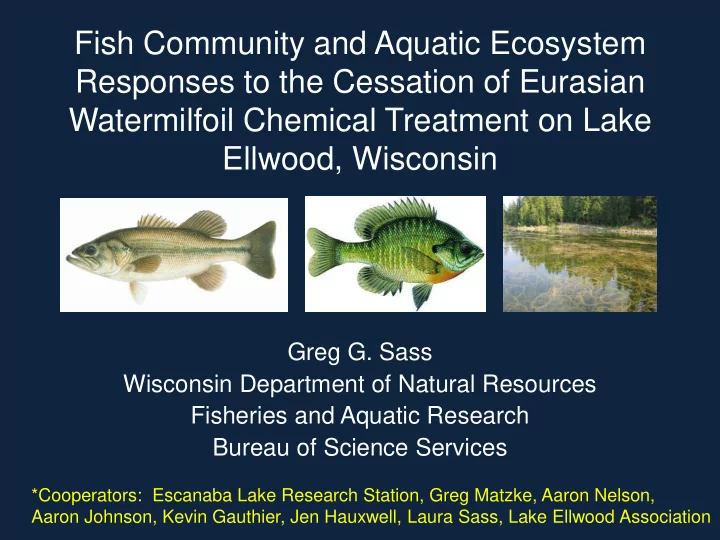

Fish Community and Aquatic Ecosystem Responses to the Cessation of Eurasian Watermilfoil Chemical Treatment on Lake Ellwood, Wisconsin Greg G. Sass Wisconsin Department of Natural Resources Fisheries and Aquatic Research Bureau of Science Services *Cooperators: Escanaba Lake Research Station, Greg Matzke, Aaron Nelson, Aaron Johnson, Kevin Gauthier, Jen Hauxwell, Laura Sass, Lake Ellwood Association
Lake Ellwood, Florence County • 135 acres • smallmouth bass, largemouth bass, bluegill, rock bass yellow perch, northern pike, black crappie, pumpkinseed, walleye, white sucker, bluntnose minnow • Invasive EWM and rusty crayfish present • Reduced lake levels due to drought • Substantial lakeshore residential development • Abundance of fish cribs • Fish community historically dominated by LMBS and BLGL
Lake Ellwood EWM Chemical Treatments • Treated annually during 2003-2012 • 2003 – 2010 (Navigate – ester) • 2011-2012 (SculpinG – amine) • No chemical treatment in 2013 and 2014 • Estimated treatment concentrations in the seasonal EWM control: some damage to native plants range at maximum • Some increases in native plant assemblages, some decreases
Fisheries Management Issue – Largemouth Bass - At least four consecutive year class failures observed in 2012 for largemouth bass; suggests persistent recruitment issues
Fisheries Management Issue - Bluegill -In healthy bluegill populations, trend would be opposite -Inconsistent year classes observed in 2012 for bluegill; suggests potential recruitment issues
Northern Wisconsin Trends in Largemouth Bass and Bluegill Indicative of strong largemouth bass recruitment over time -Relative abundance of largemouth bass has increased significantly over time; bluegill relative abundance has remained stable over time
Alternative Hypotheses to Explain Largemouth Bass and Bluegill Recruitment Declines • Insufficient spawning stock (Not Plausible, NP) • Lack of spawning (NP; spawning activity visually observed) • Eggs not viable (~P; smallmouth bass are able to spawn?, species-specific chemical effects (DeQuattro?)) • Lack of refuge prior to offshore movement of juveniles (P; refuge and predation effects) • Fish cribs serving as predator feeding stations (P; predation effects) • Lack of sufficient offshore zooplanktonic prey (P; forage base effects) • Decline in macrophyte refuge due to EWM chemical treatments (P; refuge and predation effects) • Reduced lake levels due to drought (~P; LMBS and BLGL recruitment not declining in other drought influenced lakes)
Proposed Experimental Lakes REFERENCE – REFERENCE – TREATMENT - LAKE ELLWOOD COSGROVE LAKE SEIDEL LAKE EWM PRESENT EWM ABSENT EWM PRESENT CESSATION OF EWM NO CHEMICAL NO CHEMICAL CHEMICAL TREATMENTS TREATMENTS TREATMENT (2013-2017)
Proposed Methods • Identical sampling on all three lakes (2014- 2017) • AQUATIC MACROPHYTES – sonar surveys, point transect surveys (late summer) • FISH – recruitment, relative abundance, diets, growth, habitat use (monthly) • LIMNOLOGY – Temp/DO profiles, water clarity (monthly) • ZOOPLANKTON – 80 μ m tows
Proposed Objectives 1) Test for fish community responses (recruitment, relative abundance, diet, growth, habitat use) to the cessation of EWM chemical treatments. 2) Test for aquatic ecosystem responses (invasive and native aquatic macrophyte relative abundances and species composition, limnology, zooplankton) to the cessation of EWM chemical treatments.
Proposed Benefits 1) Identify anthropogenic, abiotic, and biotic factors that may limit largemouth bass and bluegill recruitment 2) Provide scientists, managers, and lake associations with a better understanding of the response of aquatic ecosystems to the cessation of long-term chemical treatments of EWM in lakes 3) Provide scientists, managers, and lake associations with recolonization rates of EWM to better inform and balance control efforts with fish community and aquatic ecosystem considerations
Questions?
Recommend
More recommend